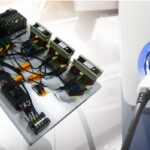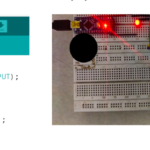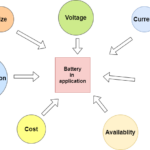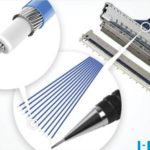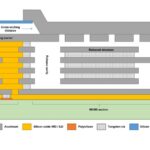by “Crutschow“, forum member on Electro-Tech-Online.com
The lowest input to output voltage drop you can get with a standard bridge rectifier is nearly a volt through the two conducting diodes for each half cycle, even with Schottky diodes in the bridge. That can generate a dissipation of about a watt per amp of output current in the bridge diodes and require a heat sink at higher current levels.
A MOSFET bridge circuit can have a very low voltage drop as determined by the ON resistance of the selected MOSFETs. Thus, a bridge drop of less than a 100 millivolts can be achieved using common, low on-resistance MOSFETs, even for relatively high output currents.
The LTspice simulation of such a circuit is shown on the right.
 The circuit certainly is more complex than a simple diode bridge, but may be worth if you need maximum output voltage and efficiency from a low voltage, bridge rectifier circuit, especially at higher current levels. Being able to avoid a bridge heat sink for higher current levels may be a sufficient reason to use the circuit, even if you don’t otherwise need the efficiency.
The circuit certainly is more complex than a simple diode bridge, but may be worth if you need maximum output voltage and efficiency from a low voltage, bridge rectifier circuit, especially at higher current levels. Being able to avoid a bridge heat sink for higher current levels may be a sufficient reason to use the circuit, even if you don’t otherwise need the efficiency.
The bridge consists of two N-MOSFETs and two P-MOSFETs. The MOSFETs actually conduct in their reverse direction and block in the forward direction, which works because MOSFETs conduct equally well in both directions when ON (they can’t block in the reverse direction due to their intrinsic substrate diodes). Thus the N-Channel MOSFET gates of M1 and M3 are simply connected to the bridge opposite side of the AC input to turn them ON for the proper time to conduct in the reverse direction for each half cycle and OFF otherwise.
The same type of gate connections can be made for the P-MOSFETs with a resistive output load, but that doesn’t work with the filter capacitor output of a typical bridge rectifier DC supply circuit. The problem is, the bi-conduction characteristic of the MOSFETs when ON means that the P-MOSFETs will conduct in the forward direction if the MOSFET is biased ON after the peak voltage is reached, and thus discharge the capacitor.
To prevent that, there are two comparators to control the gates of the P-MOSFETs, M2, and M4 respectively, and turn them ON only when the capacitor is charging, avoiding any back current discharge of the capacitor. The comparator determines the point of the respective sine-wave node where the voltage goes slightly negative with respect to ground. Thus, U1 turns on M2 during the positive peak at node 1 and U2 turns on M4 during the positive peak at node 2.
This negative voltage (due to the N-MOSFET ON resistance) means the N-MOSFET in the sensed line is starting to conduct in its reverse direction through the ground connection, indicating the capacitor is starting to charge (which initially occurs through the MOSFET substrate diode). The comparator then turns on the appropriate P-MOSFET (comparator open-collector output pulls gate to ground). As soon as this voltage turns positive, indicating the peak AC voltage is below the capacitor voltage, and it’s starting to discharge, the comparator turns the MOSFET OFF (open-collector output turns off. This allows the gate-source resistor to pull the Vgs to zero volts) and stays OFF until the voltage again starts to go negative.
[Note that neither sinewave node voltage goes significantly below ground (equal to the N-MOSFET drop from the current flow) since they are clamped to ground by the N-MOSFETs.]R6 and R7 add about 7mV of positive offset at the comparator inputs to ensure that they turn off after the capacitor stops charging. For a different input voltage, the value of R4 should be changed in direct proportion to this change, to keep the offset voltage ≈7mV.
During startup, before there is any output supply voltage to the power the comparators and the P-MOSFETs are Off, the current travels through the P-MOSFETs intrinsic substrate diodes to charge the filter capacitor. The simulation shows the MOSFETs are working properly since the output peak voltage is only about 25mV below the peak sine voltage, as can be seen in the expanded second plot down.
- The MOSFETs need to be logic-level type if the peak AC voltage is below 10V.
- The MOSFET’s ON resistance should be selected for the maximum current you want from the bridge and the maximum voltage drop and dissipation you can tolerate.
- Note that to calculate the MOSFET power dissipation you need to use a current value about double the average DC output current because of the high peak currents through the MOSFET (since power is proportional to the square of the current, high peak currents significantly increase the power dissipation over the average current value)
- It’s desirable to keep the MOSFET dissipation below the point where you need a heatsink.
- It should also have a maximum Vds rating of at least 125% of the peak AC voltage.
The maximum peak voltage of the circuit shown is determined by the Vgs limit of the MOSFETs, which is typically 20V peak. To work above that voltage, you would need to add some sort of voltage clamp to limit Vgs to below the selected MOSFETs Vgs rating.
The other limit is the maximum operating voltage of the selected comparator. If you want an output voltage above that, you will need to add a simple voltage regulator for the comparator power and limit the output voltage to its maximum. The LM339/LM393 comparator will operate from a supply and output voltage of 2V to 36V.
Note that the circuit as designed can only be used for a positive output voltage. Also, the circuit has only been simulated not built by me, so there’s always the possibility that the real circuit won’t quite work as the simulation shows, but I have good confidence that it will be close enough to be acceptable since it’s a fairly simple circuit.
(editor’s note: This article originally appeared in the Power Supply Electronic Circuits page on Electro-Tech-Online engineering community.)

